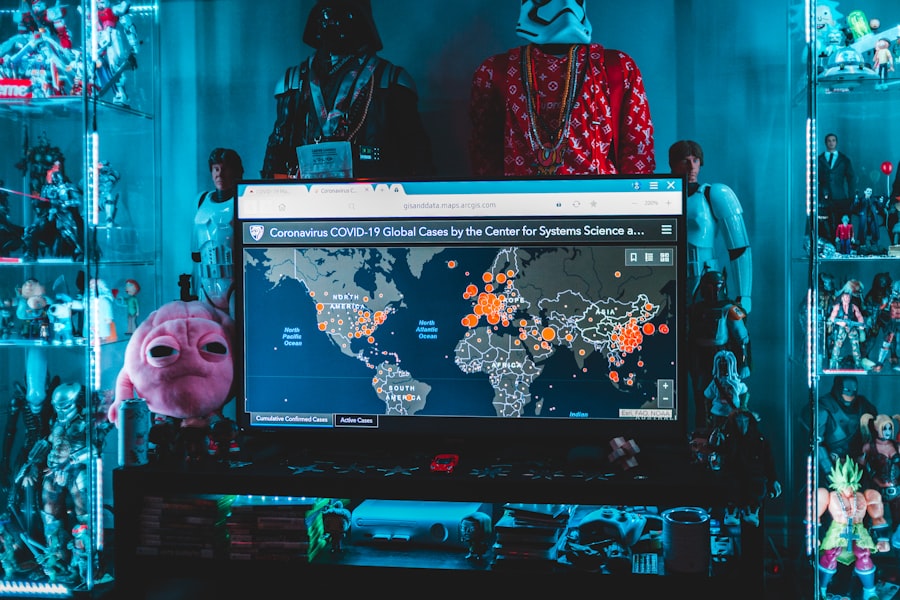The Cold War, a period marked by geopolitical tension between the Soviet Union and the United States, laid the groundwork for the emergence of cyber warfare. As both superpowers engaged in a relentless arms race, they also recognized the potential of technology as a new frontier for conflict. The development of computer technology during this era was not merely a byproduct of scientific advancement; it became a crucial element in the strategies employed by both sides.
The race to develop advanced computing systems and secure communication channels was as intense as the competition for nuclear supremacy. This technological arms race set the stage for what would eventually evolve into cyber warfare. As the Cold War progressed, the concept of information warfare began to take shape.
The ability to manipulate information and disrupt an opponent’s communication systems became increasingly important. The establishment of various intelligence agencies, such as the National Security Agency (NSA) in the United States, underscored the significance of information control. These agencies began to explore the potential of electronic warfare, which included tactics like jamming enemy communications and intercepting signals.
The seeds of cyber warfare were sown during this tumultuous period, as nations began to understand that control over information could be as powerful as control over territory.
Key Takeaways
- The Cold War marked the birth of cyber warfare, with the United States and Soviet Union engaging in espionage and sabotage through digital means.
- Early cyber warfare tactics included hacking, spreading disinformation, and disrupting communication networks, with intelligence agencies playing a key role in gathering information and carrying out cyber attacks.
- The end of the Cold War led to the evolution of cyber warfare, with non-state actors and state-sponsored cyber attacks becoming more prevalent.
- Technology has greatly influenced cyber warfare, with advancements in artificial intelligence, encryption, and offensive cyber capabilities shaping the landscape of digital conflict.
- State-sponsored cyber attacks have become a major concern in international relations, with countries using cyber warfare to gain strategic advantage and undermine their adversaries.
Early Cyber Warfare Tactics and Strategies
In the years following the Cold War, early cyber warfare tactics began to emerge, reflecting a shift in how conflicts were waged. One of the first notable instances of cyber warfare occurred in the 1980s when hackers infiltrated U.S. military networks, demonstrating vulnerabilities that had previously gone unnoticed.
These early incursions highlighted the need for robust cybersecurity measures and prompted governments to take a more proactive approach to safeguarding their digital infrastructure. The tactics employed during this time were rudimentary compared to today’s standards but laid the foundation for more sophisticated strategies that would follow. As technology advanced, so did the strategies employed in cyber warfare.
The 1990s saw an increase in the use of denial-of-service attacks, where hackers would overwhelm a target’s network with traffic, rendering it inoperable. This tactic was particularly effective against organizations that relied heavily on their online presence. Additionally, the rise of the internet provided new avenues for espionage and disruption, allowing state and non-state actors alike to exploit vulnerabilities in critical infrastructure.
The early days of cyber warfare were characterized by experimentation and adaptation, as both attackers and defenders sought to understand the evolving landscape of digital conflict.
The Role of Espionage and Intelligence Agencies

Espionage has always played a pivotal role in warfare, and with the advent of cyber capabilities, intelligence agencies found themselves at the forefront of this new battleground. Agencies like the NSA and their counterparts around the world began to invest heavily in cyber intelligence, recognizing that information superiority could dictate the outcome of conflicts. The ability to gather intelligence through cyber means allowed nations to monitor adversaries’ activities, assess their capabilities, and even influence their decision-making processes.
Moreover, cyber espionage became a tool for economic advantage as well. Nations began to target not only military secrets but also corporate intellectual property, seeking to gain an edge in technology and innovation. This shift blurred the lines between national security and economic competition, leading to a new era where cyber espionage was not just about gathering information but also about securing economic interests.
Intelligence agencies adapted their strategies to include offensive cyber operations, launching attacks designed to disrupt or degrade an adversary’s capabilities while simultaneously protecting their own assets.
The Evolution of Cyber Warfare Post-Cold War
| Year | Event | Impact |
|---|---|---|
| 1990s | First cyber attacks | Caused disruption to government and military systems |
| 2000s | Growth of cyber espionage | Stolen sensitive information from governments and corporations |
| 2010s | Rise of state-sponsored cyber attacks | Targeted critical infrastructure and political interference |
| 2020s | Increase in ransomware attacks | Disrupted businesses and demanded large payments |
The end of the Cold War marked a significant turning point in global politics and security dynamics, leading to an evolution in cyber warfare strategies. With the dissolution of the Soviet Union, new threats emerged, including rogue states and non-state actors that exploited technological advancements for malicious purposes. The rise of terrorism in the late 1990s and early 2000s further complicated the landscape, as groups sought to leverage cyber capabilities to further their agendas.
This shift necessitated a reevaluation of national security strategies, prompting governments to prioritize cybersecurity as a critical component of their defense frameworks. As conflicts in regions like the Middle East intensified, cyber warfare became an integral part of military operations. Nations began to recognize that traditional military might was no longer sufficient; they needed to incorporate cyber capabilities into their overall strategy.
The 2007 cyber attack on Estonia served as a wake-up call for many countries, illustrating how vulnerable critical infrastructure could be to coordinated cyber assaults. In response, nations began to develop comprehensive cybersecurity policies and invest in offensive capabilities, leading to a more structured approach to cyber warfare that would continue to evolve in subsequent years.
The Influence of Technology on Cyber Warfare
Technology has been both a catalyst and a weapon in the realm of cyber warfare. The rapid advancement of computing power, coupled with the proliferation of internet-connected devices, has created an environment ripe for exploitation. As technology continues to evolve, so too do the tactics employed by cyber adversaries.
The rise of artificial intelligence (AI) and machine learning has introduced new dimensions to cyber warfare, enabling attackers to automate processes and enhance their capabilities significantly. Moreover, the Internet of Things (IoT) has expanded the attack surface for potential adversaries. With billions of devices connected to the internet, each represents a potential entry point for cyber attacks.
This interconnectedness has made it increasingly challenging for organizations to secure their networks effectively. As technology continues to advance at an unprecedented pace, both state and non-state actors are forced to adapt their strategies continually, leading to an ongoing arms race in cyberspace.
The Rise of State-Sponsored Cyber Attacks

In recent years, state-sponsored cyber attacks have become a prominent feature of international relations. Governments have recognized that cyber capabilities can be wielded as tools of statecraft, allowing them to achieve strategic objectives without resorting to traditional military force. High-profile incidents such as the Stuxnet worm attack on Iran’s nuclear facilities exemplify how states can leverage cyber operations to disrupt adversaries’ critical infrastructure while maintaining plausible deniability.
These state-sponsored attacks often target not only military installations but also civilian infrastructure, financial systems, and electoral processes. The motivations behind these actions can vary from geopolitical maneuvering to economic espionage or even attempts to undermine public trust in democratic institutions. As nations increasingly engage in cyber operations as part of their foreign policy strategies, the implications for global stability become more pronounced, raising concerns about escalation and retaliation in cyberspace.
The Impact of Cyber Warfare on International Relations
The rise of cyber warfare has fundamentally altered the landscape of international relations. Traditional notions of sovereignty are challenged as nations grapple with how to respond to attacks that transcend borders and often involve non-state actors. Cyber incidents can escalate tensions between countries, leading to diplomatic crises or even military confrontations.
The difficulty in attributing attacks complicates responses; nations may hesitate to retaliate against perceived aggressors due to uncertainty about who is truly behind an attack. Furthermore, cyber warfare has introduced new dynamics into alliances and partnerships among nations. Countries are increasingly collaborating on cybersecurity initiatives, sharing intelligence about threats and vulnerabilities while developing joint strategies for defense and response.
However, this collaboration is not without its challenges; differing national interests and varying levels of technological capability can create friction among allies. As states navigate this complex landscape, they must balance cooperation with competition in an era where cyber capabilities are integral to national security.
The Legal and Ethical Considerations of Cyber Warfare
The legal framework governing cyber warfare remains murky at best. Existing international laws were primarily designed for traditional warfare and do not adequately address the unique challenges posed by cyber operations. Questions arise regarding what constitutes an act of war in cyberspace and how nations should respond when attacked.
The lack of clear legal definitions complicates matters further; states may find themselves operating in a gray area where actions could be interpreted differently depending on context. Ethical considerations also come into play when discussing cyber warfare. The potential for collateral damage is significant; attacks on critical infrastructure can have far-reaching consequences for civilian populations.
As nations grapple with these ethical dilemmas, they must consider not only their strategic objectives but also the humanitarian implications of their actions in cyberspace. Striking a balance between national security interests and ethical responsibilities presents a formidable challenge for policymakers navigating this evolving domain.
The Role of Non-State Actors in Cyber Warfare
Non-state actors have emerged as significant players in the realm of cyber warfare, complicating traditional notions of conflict and security. Hacktivist groups, criminal organizations, and even terrorist cells have leveraged digital tools to advance their agendas or disrupt established systems.
The motivations driving non-state actors vary widely; some seek political change through disruptive tactics while others pursue financial gain through cybercrime. Their ability to operate anonymously online allows them to evade detection and prosecution, further complicating efforts by law enforcement agencies and intelligence services. As non-state actors continue to evolve and adapt their strategies, they pose unique challenges for national security frameworks that must account for both state-sponsored threats and independent malicious actors.
The Future of Cyber Warfare: Challenges and Opportunities
Looking ahead, the future of cyber warfare presents both challenges and opportunities for nations worldwide. As technology continues to advance rapidly, so too will the capabilities available to both attackers and defenders. Nations must invest in robust cybersecurity measures while also developing offensive capabilities that can deter potential adversaries from launching attacks.
This dual approach will be essential in navigating an increasingly complex digital landscape. Moreover, international cooperation will be crucial in addressing shared challenges posed by cyber threats. Collaborative efforts among nations can lead to improved information sharing, joint exercises, and collective responses to incidents that transcend borders.
However, achieving consensus on norms and regulations governing cyberspace will require ongoing dialogue among states with differing interests and perspectives on cybersecurity issues.
The Global Response to Cyber Warfare
In response to the growing threat posed by cyber warfare, nations around the world have begun implementing comprehensive strategies aimed at enhancing their cybersecurity posture. Governments are investing heavily in developing advanced technologies capable of detecting and mitigating cyber threats while also fostering public-private partnerships that leverage expertise from both sectors. These initiatives aim not only to protect critical infrastructure but also to build resilience against potential attacks.
International organizations are also playing a vital role in shaping global responses to cyber warfare. Initiatives such as the United Nations’ efforts to establish norms for responsible state behavior in cyberspace reflect a growing recognition that collaborative approaches are necessary for addressing shared challenges. As nations work together to develop frameworks for cooperation and response mechanisms, they must remain vigilant against evolving threats while fostering an environment conducive to innovation and security in cyberspace.
In conclusion, as we navigate this complex landscape shaped by technological advancements and evolving geopolitical dynamics, it is imperative that nations prioritize collaboration over competition in addressing the challenges posed by cyber warfare.
The origins of cyber warfare can be traced back to the Cold War era, a time when technological advancements were rapidly evolving and the digital landscape was beginning to take shape. During this period, both superpowers, the United States and the Soviet Union, were engaged in a relentless pursuit of technological superiority, which laid the groundwork for modern cyber conflicts. For a deeper understanding of how these early developments have influenced contemporary cyber warfare strategies, you can explore a related article on this topic by visiting In The War Room. This article delves into the historical context and the pivotal moments that have shaped the cyber warfare tactics we see today.
WATCH THIS 🤯How the KGB Stole America’s Future
FAQs
What is cyber warfare?
Cyber warfare refers to the use of digital technology to attack and defend against other nations’ computer systems and networks. It can involve hacking, espionage, and sabotage in the digital realm.
What are the origins of cyber warfare?
The origins of cyber warfare can be traced back to the Cold War, when the United States and the Soviet Union engaged in espionage and sabotage activities using early computer technology.
How did the Cold War contribute to the development of cyber warfare?
During the Cold War, both the United States and the Soviet Union recognized the potential of using computer technology for espionage and sabotage. This led to the development of early cyber warfare tactics and strategies.
What were some early examples of cyber warfare during the Cold War?
During the Cold War, both the United States and the Soviet Union engaged in cyber espionage and sabotage activities. For example, the United States used computer technology to gather intelligence on the Soviet Union, while the Soviet Union attempted to infiltrate American computer systems.
How has cyber warfare evolved since the Cold War?
Since the Cold War, cyber warfare has evolved significantly, with advancements in technology leading to more sophisticated tactics and strategies. Nations now have dedicated cyber warfare units and capabilities, and cyber attacks have become a major concern for national security.




